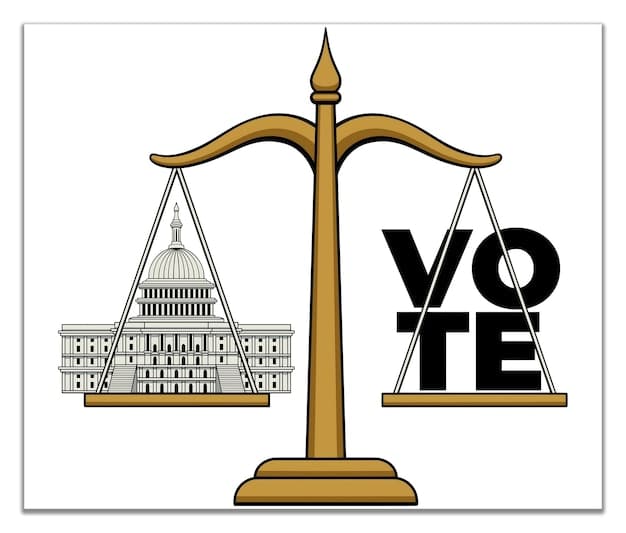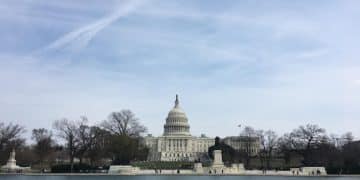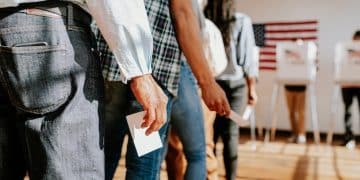Supreme Court’s Impact: Voting Rights Legislation in the US

New Supreme Court appointments can significantly reshape voting rights legislation in the US, potentially leading to stricter voter ID laws, altered redistricting processes, and changes in the enforcement of existing voting rights protections.
The composition of the Supreme Court plays a pivotal role in interpreting and shaping legislation, particularly in sensitive areas like voting rights. Understanding how will the new supreme court appointments affect voting rights legislation in the US is crucial for anyone interested in the future of American democracy.
The Supreme Court’s Role in Shaping Voting Rights
The Supreme Court is the final arbiter of constitutional law, and its decisions regarding voting rights have a profound and lasting impact. Its rulings can either reinforce or weaken existing protections, significantly altering the accessibility and fairness of elections.
Understanding the Supreme Court’s influence requires looking at key cases and how those rulings have transformed the landscape of voting rights in the United States.
Landmark Supreme Court Cases on Voting Rights
The Supreme Court has shaped voting rights through several key decisions over the decades.
- Baker v. Carr (1962): This case established the principle of “one person, one vote,” requiring that legislative districts be roughly equal in population to ensure fair representation.
- Reynolds v. Sims (1964): Expanding on Baker v. Carr, this ruling applied the “one person, one vote” principle to state legislative districts, further ensuring equal representation at the state level.
- Harper v. Virginia Board of Elections (1966): The Court struck down poll taxes in state elections, finding them unconstitutional under the Equal Protection Clause of the Fourteenth Amendment.
- Shelby County v. Holder (2013): This controversial decision effectively gutted Section 5 of the Voting Rights Act of 1965, which had required certain states with a history of discrimination to obtain federal preclearance before changing their voting laws.
These cases illustrate the Court’s power to define the scope and enforcement of voting rights protections.
In conclusion, the Supreme Court’s historical rulings demonstrate its ongoing influence on voting rights, shaping the legal framework that governs elections in the United States.

Potential Impacts of New Appointments on Voting Rights
New appointments to the Supreme Court can shift the Court’s ideological balance, potentially leading to changes in how voting rights cases are decided. Such shifts can reverberate through election laws and practices across the nation.
Understanding potential impacts requires considering how new justices might approach key issues in voting rights legislation.
Key Areas of Potential Change
Several aspects of voting rights legislation could be affected by new Supreme Court justices.
- Voter ID Laws: Stricter interpretations of voter ID requirements could make it harder for some citizens, particularly those in marginalized communities, to vote.
- Redistricting: The Court’s approach to gerrymandering cases could either curb or enable partisan manipulation of electoral district boundaries.
- Enforcement of the Voting Rights Act: The extent to which the Court is willing to uphold and enforce the remaining provisions of the Voting Rights Act will be critical.
- Campaign Finance Regulations: Decisions on campaign finance could affect the ability of groups to influence elections and voter turnout.
These areas highlight the varied ways in which judicial interpretations can shape the electoral process.
In summary, new appointments to the Supreme Court can significantly alter the trajectory of voting rights law, affecting voter access, representation, and the integrity of elections.
Voter ID Laws and the Supreme Court
Voter ID laws, which require voters to present identification at the polls, have long been a contentious issue in American politics. Proponents argue they are necessary to prevent voter fraud, while opponents contend they disproportionately disenfranchise minority and low-income voters.
The Supreme Court’s stance on voter ID laws could change significantly with new appointments.
The Court’s Current Position
The current Supreme Court has generally been more sympathetic to state efforts to implement voter ID laws, often upholding such laws against legal challenges.
However, the legal landscape could shift depending on the composition of the Court. A more liberal Court might be more inclined to scrutinize voter ID laws for potential discriminatory effects, while a more conservative Court might be more deferential to state legislatures. This is especially true when considering the burden it could place on the less privileged.
Potential Future Challenges
Several challenges related to voter ID laws may reach the Supreme Court in the coming years. These include cases involving:
- Strict Photo ID Requirements: Challenges to laws that require voters to present specific forms of photo identification, arguing they create unnecessary barriers to voting.
- Proof of Residency Requirements: Cases challenging requirements that voters provide proof of residency, as these can disproportionately affect those who move frequently or lack stable housing.
- Limited Accepted Forms of ID: Lawsuits arguing that the limited types of identification accepted at the polls discriminate against certain groups of voters.
These challenges underscore the ongoing debate over voter ID laws and their potential impact on different communities.

Redistricting and Gerrymandering
Redistricting, the process of redrawing electoral district boundaries, is another area where Supreme Court decisions can have a major impact on voting rights. Gerrymandering, the practice of drawing district lines to favor one political party over another, has been a persistent problem in American elections.
New Supreme Court appointments could alter the Court’s approach to gerrymandering cases, potentially curbing or enabling partisan manipulation of electoral districts.
The Court’s Role in Redistricting
The Supreme Court has struggled to define clear and consistent standards for evaluating gerrymandering claims. While the Court has acknowledged that extreme partisan gerrymandering can be unconstitutional, it has also found it difficult to articulate a manageable legal standard for determining when a redistricting plan crosses the line.
The Court’s lack of consensus on this issue has allowed partisan gerrymandering to continue in many states, resulting in electoral maps that are heavily skewed in favor of one party.
Potential Future Cases
Upcoming Supreme Court cases on redistricting could focus on several key issues:
- Partisan Gerrymandering: The Court may revisit the question of whether and how to regulate partisan gerrymandering, potentially adopting new legal standards for evaluating redistricting plans.
- Racial Gerrymandering: Cases alleging that redistricting plans intentionally dilute the voting power of racial minorities may continue to reach the Court.
- Independent Redistricting Commissions: The Court may consider the constitutionality of independent redistricting commissions, which are designed to take the redistricting process out of the hands of partisan politicians.
These cases will shape the future of redistricting and the fairness of electoral maps across the United States.
The Voting Rights Act and Section 2
The Voting Rights Act of 1965 (VRA) is a landmark piece of legislation that prohibits racial discrimination in voting. While Section 5 of the VRA has been weakened by the Supreme Court’s decision in Shelby County v. Holder, Section 2 remains a critical tool for protecting voting rights.
Section 2 prohibits voting practices that discriminate on the basis of race, color, or membership in a language minority group. It allows individuals and organizations to sue jurisdictions that have discriminatory voting practices.
The Importance of Section 2
Section 2 of the VRA has been used to challenge a variety of discriminatory voting practices, including:
- Vote Dilution: Lawsuits alleging that electoral systems dilute the voting power of minority groups by preventing them from electing their candidates of choice.
- Discriminatory Election Procedures: Challenges to election procedures that create barriers for minority voters, such as limited polling locations or inadequate language assistance.
- At-Large Elections: Cases arguing that at-large election systems, where candidates are elected to represent an entire jurisdiction rather than individual districts, can disadvantage minority candidates.
Section 2 has been instrumental in promoting fair and equal access to the ballot box for all Americans.
In summary, the Voting Rights Act, particularly Section 2, remains a vital safeguard against discriminatory voting practices, ensuring equal access to the democratic process for all citizens.
The Future of Voting Rights Legislation
The future of voting rights legislation in the United States is uncertain, with ongoing debates over voter ID laws, redistricting, and the enforcement of the Voting Rights Act. New appointments to the Supreme Court will play a crucial role in shaping the legal landscape of voting rights.
The outcomes of these debates will have a profound impact on the accessibility and fairness of elections, as well as the representation of diverse communities across the country.
Key Considerations for the Future
Several key considerations will shape the future of voting rights legislation:
- Federal Legislation: Efforts to pass new federal legislation to strengthen voting rights protections and address the effects of the Shelby County decision.
- State-Level Reforms: State-level initiatives to expand access to the ballot box, such as automatic voter registration, same-day registration, and early voting.
- Litigation Strategies: Ongoing litigation efforts to challenge discriminatory voting practices and protect the rights of voters.
These considerations highlight the ongoing commitment to ensuring fair and equal access to the ballot box for all Americans.
| Key Concept | Brief Description |
|---|---|
| ⚖️ Supreme Court’s Role | Final arbiter on voting rights; decisions shape access and fairness. |
| 🆔 Voter ID Laws | Require voters to present ID; debated for impact on minority voters. |
| 🗺️ Redistricting | Redrawing district lines; gerrymandering manipulates voting power. |
| 🛡️ Voting Rights Act | Prohibits racial discrimination in voting; Section 2 is still vital. |
Frequently Asked Questions
▼
New appointments can shift the Court’s ideological balance, impacting voting rights cases. Different justices may interpret existing laws and precedents differently, leading to varied outcomes in key legal challenges.
▼
Gerrymandering is the practice of drawing electoral district boundaries to favor one political party. It is important because it can distort the will of the voters and create unfair electoral advantages for particular groups.
▼
Section 2 prohibits voting practices that discriminate based on race, color, or language minority status. It allows lawsuits against discriminatory election practices, promoting fair access to the ballot box for all citizens.
▼
Voter ID laws are controversial because proponents claim they prevent fraud, while opponents argue they disproportionately disenfranchise minority and low-income voters who may have difficulty obtaining required identification.
▼
Ongoing challenges include debates over voter ID laws, partisan gerrymandering, restrictions on early voting, and efforts to weaken or limit the enforcement of the Voting Rights Act, all affecting voter access.
Conclusion
In conclusion, understanding how will the new supreme court appointments affect voting rights legislation in the US is essential for safeguarding American democracy, and by staying informed and engaged, citizens can actively shape the future of voting rights and ensure fair representation.





